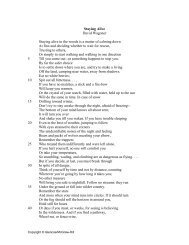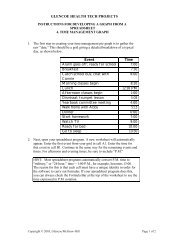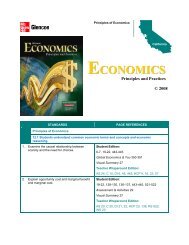Math Handbook - Glencoe
Math Handbook - Glencoe
Math Handbook - Glencoe
Create successful ePaper yourself
Turn your PDF publications into a flip-book with our unique Google optimized e-Paper software.
Most scientific calculators have a button labeled log and, in most cases, the<br />
number is simply entered and the log button is pushed to display the log of<br />
the number. Note that there is the same number of digits after the decimal in<br />
the log as there are significant figures in the original number entered.<br />
log 5.34 10 5 log 5.34 log10 5 0.728 5 5.728<br />
Suppose the pH of the aqueous ammonia in Figure 23 is 9.54 and you are<br />
asked to find the concentration of the hydrogen ions in that solution. By definition,<br />
pH log [H ]. Compare this to the general equation for the common<br />
log.<br />
Equation for pH: pH log [H ]<br />
General equation:<br />
y log 10 n<br />
To solve the equation for [H ], you must follow the reverse process and calculate<br />
the antilogarithm (antilog) of 9.54 to find [H ].<br />
Antilogs are the reverse of logs. To find the antilog, use a scientific calculator<br />
to input the value of the log. Then, use the inverse function and press<br />
the log button.<br />
APPENDIX B<br />
<strong>Math</strong><br />
<strong>Handbook</strong><br />
Exponential Notation<br />
Properties of Exponents<br />
Logarithm<br />
10 A 10 B 10 A B log (A B) = log A log B<br />
10 A 10 B 10 A B log (A B) log A log B<br />
A B<br />
If n antilog y, then y 10 n .<br />
Thus, [H ] antilog(9.54) 10 9.54 10<br />
10 0.46 10 10<br />
2.9 10 10 M<br />
(log A) B<br />
0.46 (10)<br />
Check the instruction manual for your calculator. The exact procedure to calculate<br />
logs and antilogs may vary.<br />
Table 5<br />
Figure 23<br />
Ammonia is a base. That means,<br />
its hydrogen ion concentration is<br />
less than 10 7 .<br />
<strong>Math</strong> <strong>Handbook</strong><br />
PRACTICE PROBLEMS<br />
21. Find the log of each of the following numbers:<br />
a. 367 c. X n<br />
b. 4078 d. ( 1 2 ) t/T<br />
22. Find the antilog of each of the following logs:<br />
a. 4.663 c. 0.371<br />
b. 2.367 d. 1.588<br />
<strong>Math</strong> <strong>Handbook</strong> 911
















